fuel MAZDA MODEL B3000 TRUCK 2005 Owner's Manual
[x] Cancel search | Manufacturer: MAZDA, Model Year: 2005, Model line: MODEL B3000 TRUCK, Model: MAZDA MODEL B3000 TRUCK 2005Pages: 256, PDF Size: 2 MB
Page 145 of 256
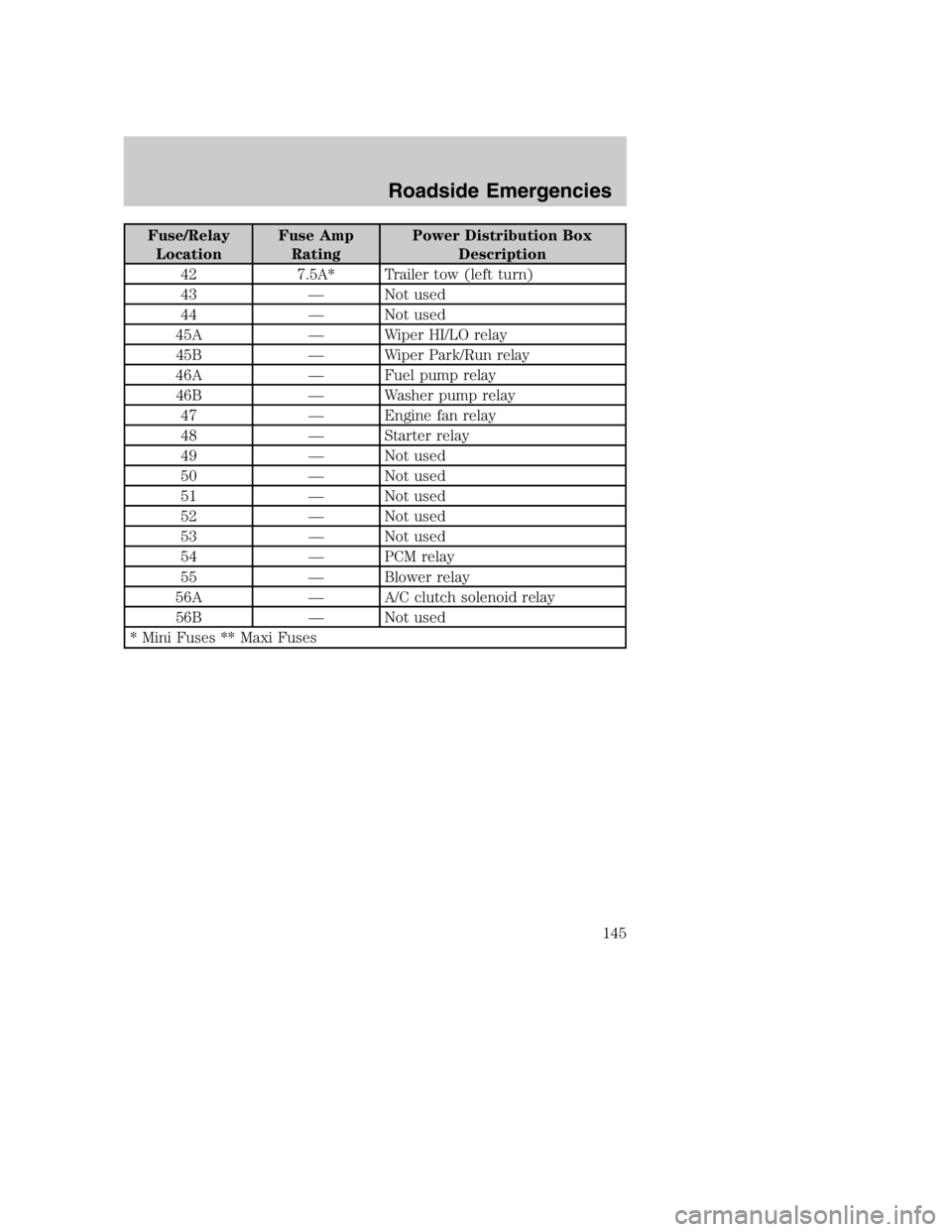
Fuse/RelayLocation Fuse Amp
Rating Power Distribution Box
Description
42 7.5A* Trailer tow (left turn)
43 — Not used
44 — Not used
45A — Wiper HI/LO relay 45B — Wiper Park/Run relay
46A — Fuel pump relay 46B — Washer pump relay 47 — Engine fan relay
48 — Starter relay
49 — Not used
50 — Not used
51 — Not used
52 — Not used
53 — Not used
54 — PCM relay
55 — Blower relay
56A — A/C clutch solenoid relay 56B — Not used
* Mini Fuses ** Maxi Fuses
2004 Mazda B Series (mbs)
Owners Guide (post-2002-fmt)
USA English (fus)
Roadside Emergencies
145
Page 147 of 256
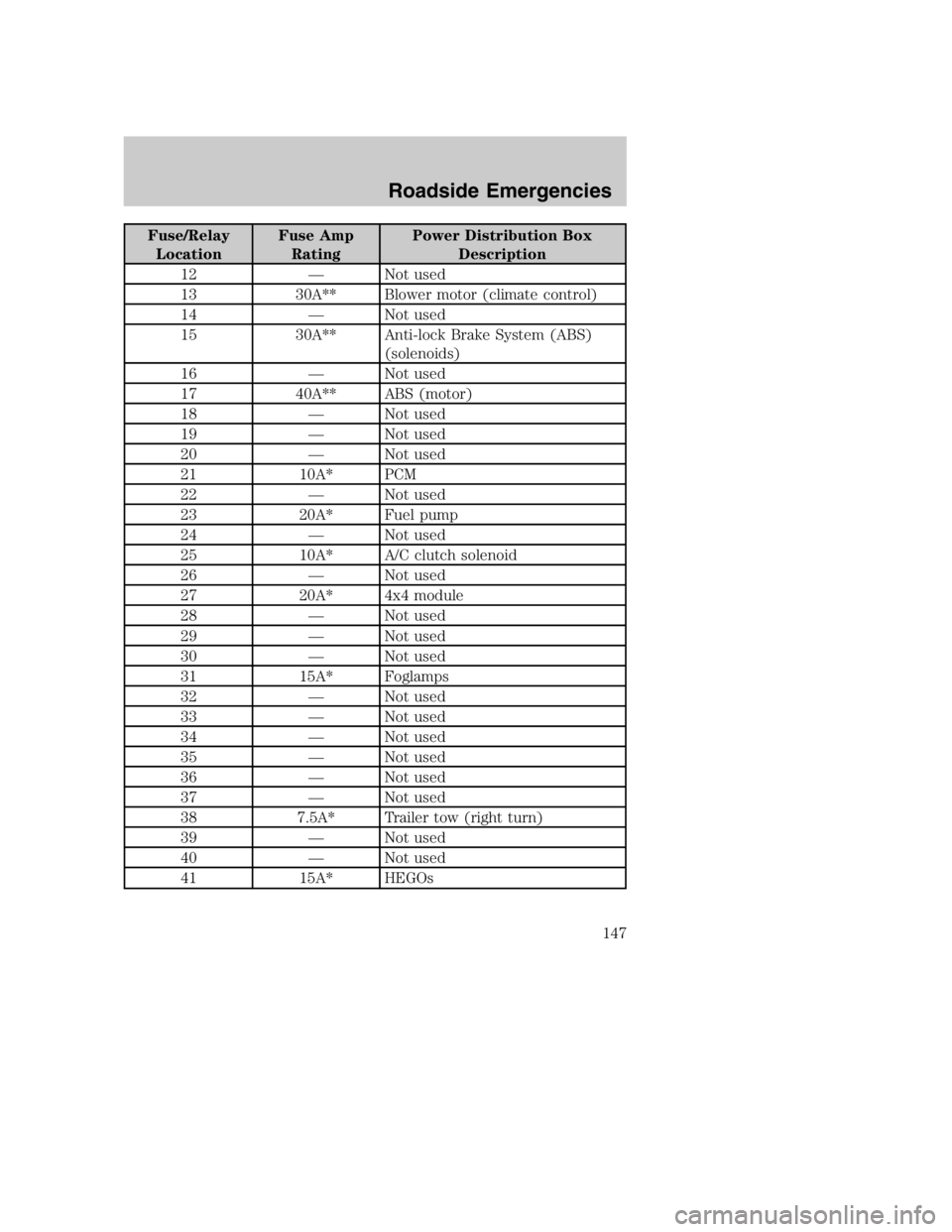
Fuse/RelayLocation Fuse Amp
Rating Power Distribution Box
Description
12 — Not used
13 30A** Blower motor (climate control)
14 — Not used
15 30A** Anti-lock Brake System (ABS) (solenoids)
16 — Not used
17 40A** ABS (motor)
18 — Not used
19 — Not used
20 — Not used
21 10A* PCM
22 — Not used
23 20A* Fuel pump
24 — Not used
25 10A* A/C clutch solenoid
26 — Not used
27 20A* 4x4 module
28 — Not used
29 — Not used
30 — Not used
31 15A* Foglamps
32 — Not used
33 — Not used
34 — Not used
35 — Not used
36 — Not used
37 — Not used
38 7.5A* Trailer tow (right turn)
39 — Not used
40 — Not used
41 15A* HEGOs
2004 Mazda B Series (mbs)
Owners Guide (post-2002-fmt)
USA English (fus)
Roadside Emergencies
147
Page 148 of 256
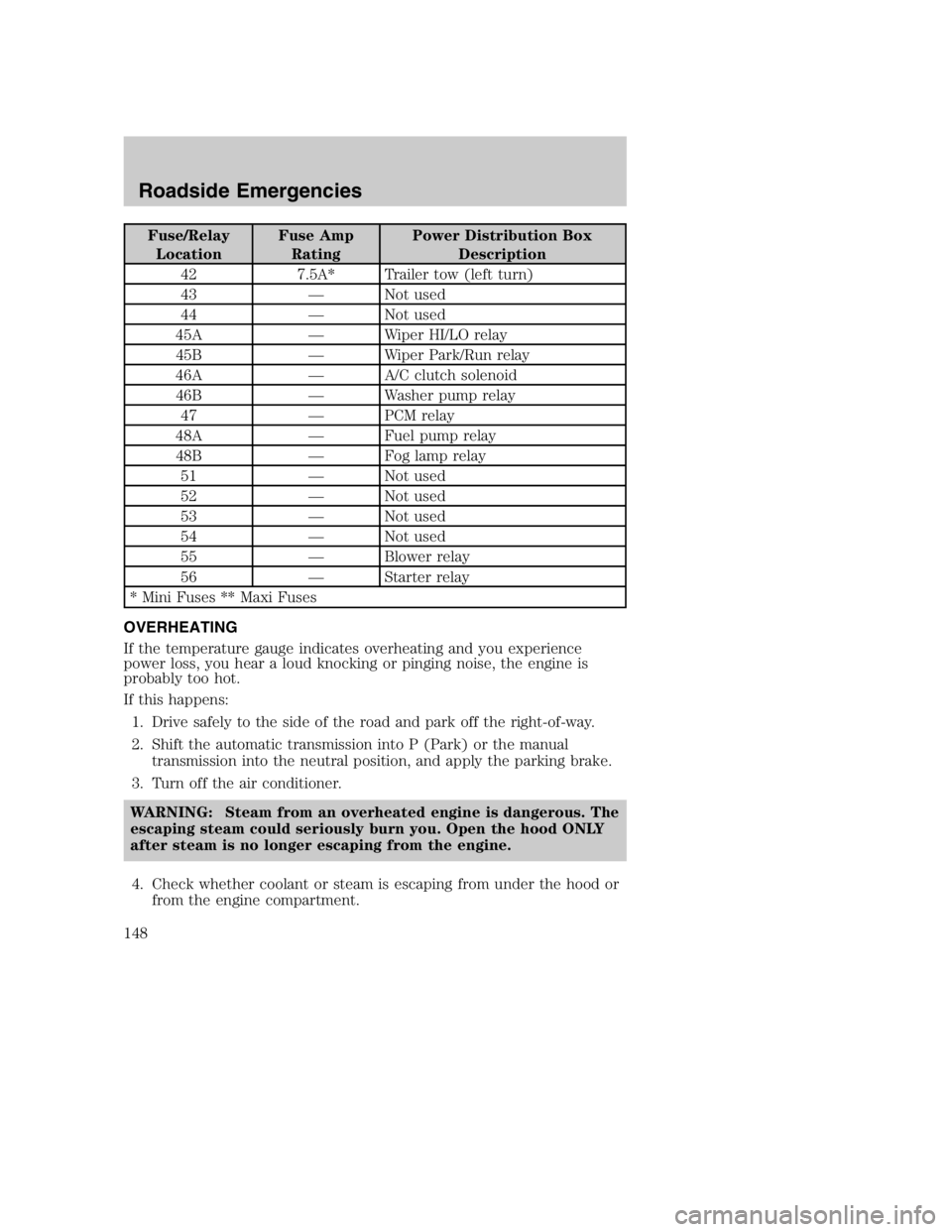
Fuse/RelayLocation Fuse Amp
Rating Power Distribution Box
Description
42 7.5A* Trailer tow (left turn)
43 — Not used
44 — Not used
45A — Wiper HI/LO relay 45B — Wiper Park/Run relay
46A — A/C clutch solenoid 46B — Washer pump relay 47 — PCM relay
48A — Fuel pump relay 48B — Fog lamp relay 51 — Not used
52 — Not used
53 — Not used
54 — Not used
55 — Blower relay
56 — Starter relay
* Mini Fuses ** Maxi Fuses
OVERHEATING
If the temperature gauge indicates overheating and you experience
power loss, you hear a loud knocking or pinging noise, the engine is
probably too hot.
If this happens: 1. Drive safely to the side of the road and park off the right-of-way.
2. Shift the automatic transmission into P (Park) or the manual transmission into the neutral position, and apply the parking brake.
3. Turn off the air conditioner.
WARNING: Steam from an overheated engine is dangerous. The
escaping steam could seriously burn you. Open the hood ONLY
after steam is no longer escaping from the engine.
4. Check whether coolant or steam is escaping from under the hood or from the engine compartment.
2004 Mazda B Series (mbs)
Owners Guide (post-2002-fmt)
USA English (fus)
Roadside Emergencies
148
Page 159 of 256
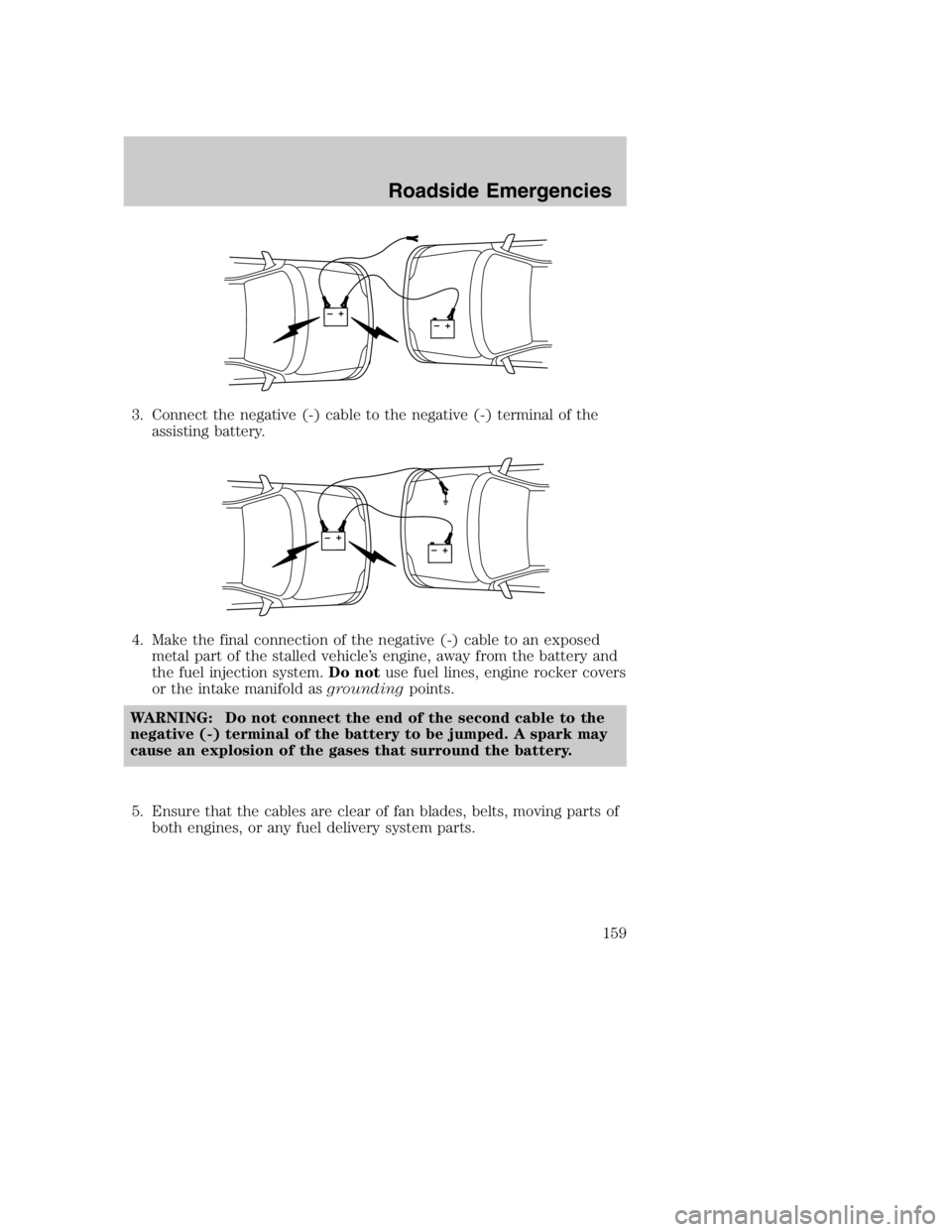
3. Connect the negative (-) cable to the negative (-) terminal of theassisting battery.
4. Make the final connection of the negative (-) cable to an exposed metal part of the stalled vehicle’s engine, away from the battery and
the fuel injection system. Do notuse fuel lines, engine rocker covers
or the intake manifold as groundingpoints.
WARNING: Do not connect the end of the second cable to the
negative (-) terminal of the battery to be jumped. A spark may
cause an explosion of the gases that surround the battery.
5. Ensure that the cables are clear of fan blades, belts, moving parts of both engines, or any fuel delivery system parts.
+–+–
+–+–
2004 Mazda B Series (mbs)
Owners Guide (post-2002-fmt)
USA English (fus)
Roadside Emergencies
159
Page 170 of 256
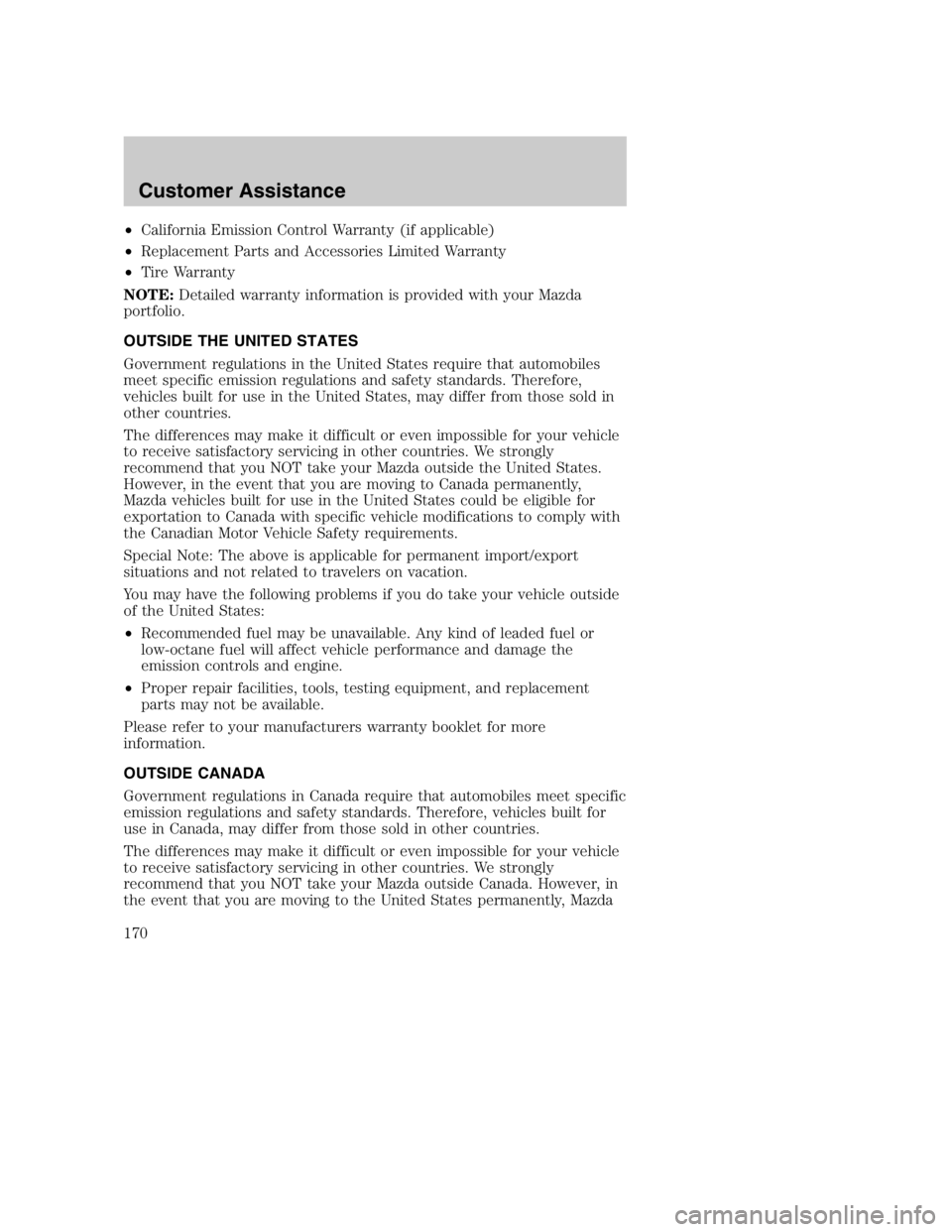
•California Emission Control Warranty (if applicable)
• Replacement Parts and Accessories Limited Warranty
• Tire Warranty
NOTE: Detailed warranty information is provided with your Mazda
portfolio.
OUTSIDE THE UNITED STATES
Government regulations in the United States require that automobiles
meet specific emission regulations and safety standards. Therefore,
vehicles built for use in the United States, may differ from those sold in
other countries.
The differences may make it difficult or even impossible for your vehicle
to receive satisfactory servicing in other countries. We strongly
recommend that you NOT take your Mazda outside the United States.
However, in the event that you are moving to Canada permanently,
Mazda vehicles built for use in the United States could be eligible for
exportation to Canada with specific vehicle modifications to comply with
the Canadian Motor Vehicle Safety requirements.
Special Note: The above is applicable for permanent import/export
situations and not related to travelers on vacation.
You may have the following problems if you do take your vehicle outside
of the United States:
• Recommended fuel may be unavailable. Any kind of leaded fuel or
low-octane fuel will affect vehicle performance and damage the
emission controls and engine.
• Proper repair facilities, tools, testing equipment, and replacement
parts may not be available.
Please refer to your manufacturers warranty booklet for more
information.
OUTSIDE CANADA
Government regulations in Canada require that automobiles meet specific
emission regulations and safety standards. Therefore, vehicles built for
use in Canada, may differ from those sold in other countries.
The differences may make it difficult or even impossible for your vehicle
to receive satisfactory servicing in other countries. We strongly
recommend that you NOT take your Mazda outside Canada. However, in
the event that you are moving to the United States permanently, Mazda
2004 Mazda B Series (mbs)
Owners Guide (post-2002-fmt)
USA English (fus)
Customer Assistance
170
Page 171 of 256
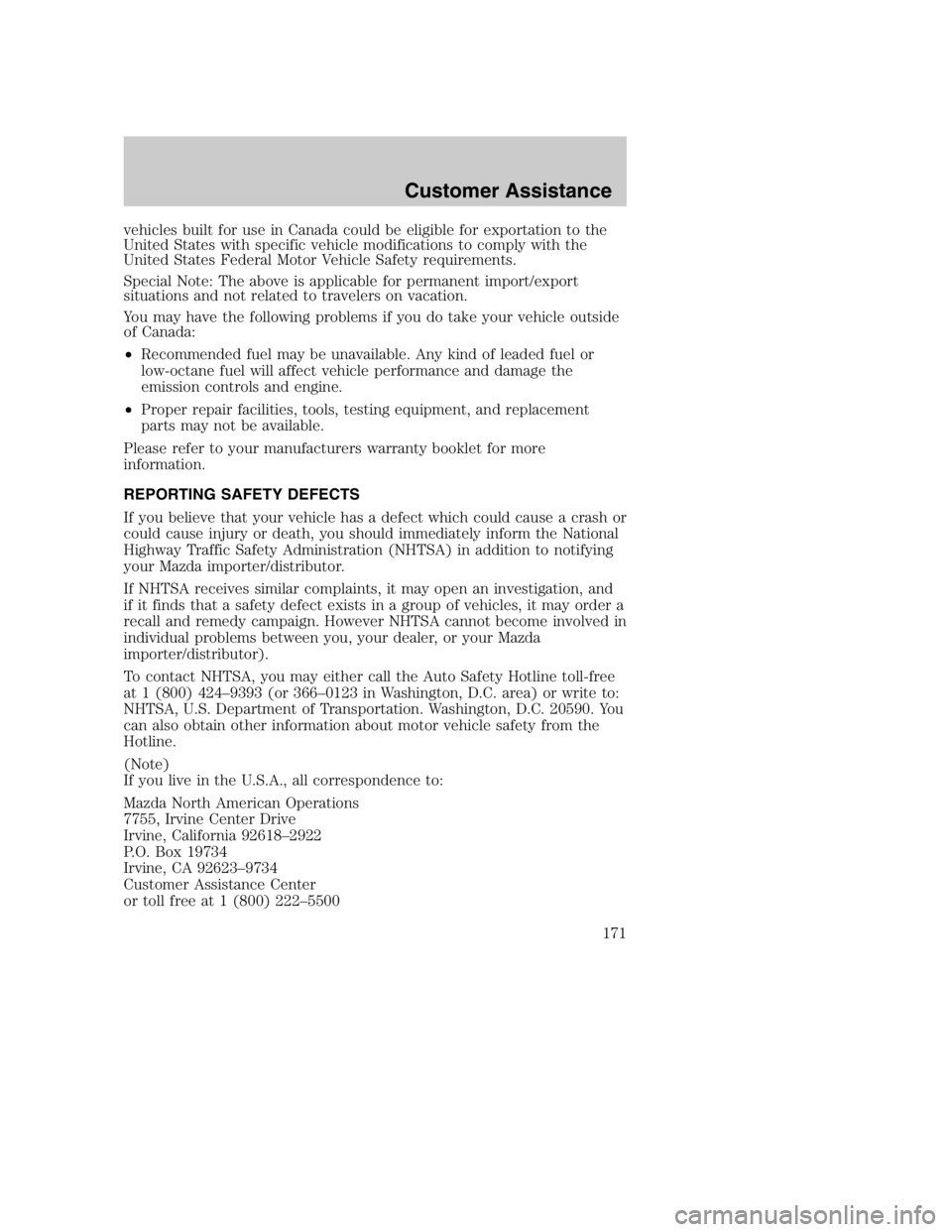
vehicles built for use in Canada could be eligible for exportation to the
United States with specific vehicle modifications to comply with the
United States Federal Motor Vehicle Safety requirements.
Special Note: The above is applicable for permanent import/export
situations and not related to travelers on vacation.
You may have the following problems if you do take your vehicle outside
of Canada:
•Recommended fuel may be unavailable. Any kind of leaded fuel or
low-octane fuel will affect vehicle performance and damage the
emission controls and engine.
• Proper repair facilities, tools, testing equipment, and replacement
parts may not be available.
Please refer to your manufacturers warranty booklet for more
information.
REPORTING SAFETY DEFECTS
If you believe that your vehicle has a defect which could cause a crash or
could cause injury or death, you should immediately inform the National
Highway Traffic Safety Administration (NHTSA) in addition to notifying
your Mazda importer/distributor.
If NHTSA receives similar complaints, it may open an investigation, and
if it finds that a safety defect exists in a group of vehicles, it may order a
recall and remedy campaign. However NHTSA cannot become involved in
individual problems between you, your dealer, or your Mazda
importer/distributor).
To contact NHTSA, you may either call the Auto Safety Hotline toll-free
at 1 (800) 424–9393 (or 366–0123 in Washington, D.C. area) or write to:
NHTSA, U.S. Department of Transportation. Washington, D.C. 20590. You
can also obtain other information about motor vehicle safety from the
Hotline.
(Note)
If you live in the U.S.A., all correspondence to:
Mazda North American Operations
7755, Irvine Center Drive
Irvine, California 92618–2922
P.O. Box 19734
Irvine, CA 92623–9734
Customer Assistance Center
or toll free at 1 (800) 222–5500
2004 Mazda B Series (mbs)
Owners Guide (post-2002-fmt)
USA English (fus)
Customer Assistance
171
Page 174 of 256
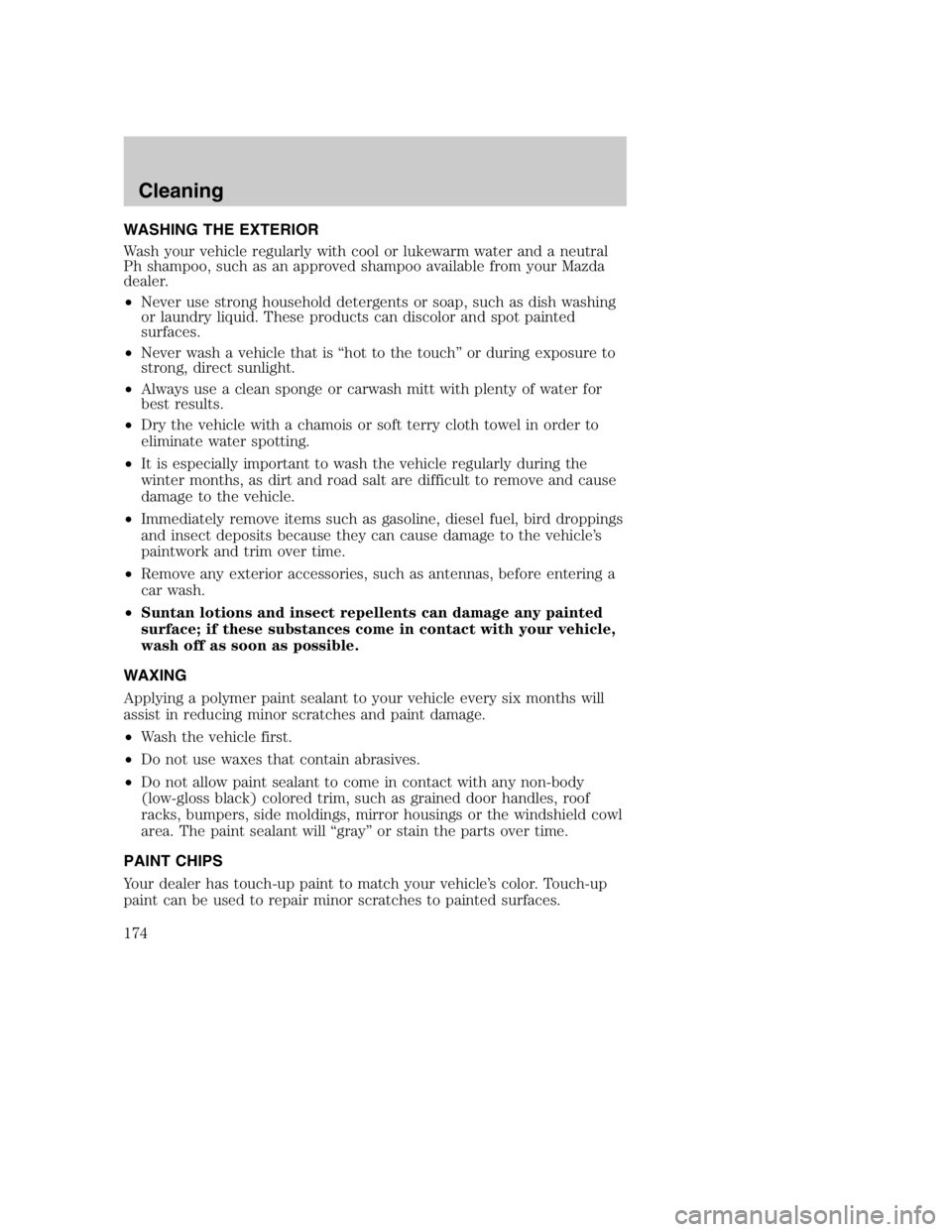
WASHING THE EXTERIOR
Wash your vehicle regularly with cool or lukewarm water and a neutral
Ph shampoo, such as an approved shampoo available from your Mazda
dealer.
•Never use strong household detergents or soap, such as dish washing
or laundry liquid. These products can discolor and spot painted
surfaces.
• Never wash a vehicle that is “hot to the touch” or during exposure to
strong, direct sunlight.
• Always use a clean sponge or carwash mitt with plenty of water for
best results.
• Dry the vehicle with a chamois or soft terry cloth towel in order to
eliminate water spotting.
• It is especially important to wash the vehicle regularly during the
winter months, as dirt and road salt are difficult to remove and cause
damage to the vehicle.
• Immediately remove items such as gasoline, diesel fuel, bird droppings
and insect deposits because they can cause damage to the vehicle’s
paintwork and trim over time.
• Remove any exterior accessories, such as antennas, before entering a
car wash.
• Suntan lotions and insect repellents can damage any painted
surface; if these substances come in contact with your vehicle,
wash off as soon as possible.
WAXING
Applying a polymer paint sealant to your vehicle every six months will
assist in reducing minor scratches and paint damage.
• Wash the vehicle first.
• Do not use waxes that contain abrasives.
• Do not allow paint sealant to come in contact with any non-body
(low-gloss black) colored trim, such as grained door handles, roof
racks, bumpers, side moldings, mirror housings or the windshield cowl
area. The paint sealant will “gray” or stain the parts over time.
PAINT CHIPS
Your dealer has touch-up paint to match your vehicle’s color. Touch-up
paint can be used to repair minor scratches to painted surfaces.
2004 Mazda B Series (mbs)
Owners Guide (post-2002-fmt)
USA English (fus)
Cleaning
Cleaning
174
Page 175 of 256
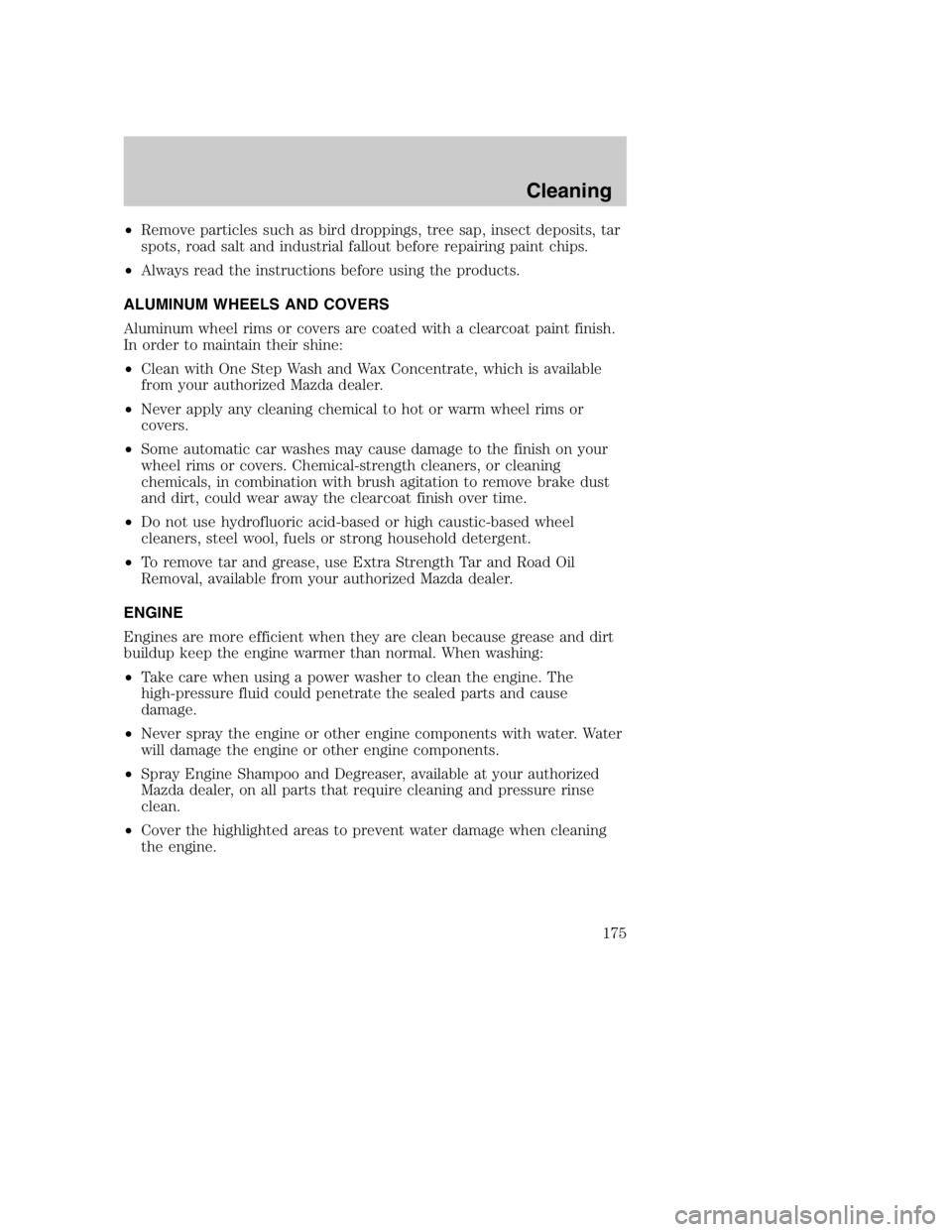
•Remove particles such as bird droppings, tree sap, insect deposits, tar
spots, road salt and industrial fallout before repairing paint chips.
• Always read the instructions before using the products.
ALUMINUM WHEELS AND COVERS
Aluminum wheel rims or covers are coated with a clearcoat paint finish.
In order to maintain their shine:
• Clean with One Step Wash and Wax Concentrate, which is available
from your authorized Mazda dealer.
• Never apply any cleaning chemical to hot or warm wheel rims or
covers.
• Some automatic car washes may cause damage to the finish on your
wheel rims or covers. Chemical-strength cleaners, or cleaning
chemicals, in combination with brush agitation to remove brake dust
and dirt, could wear away the clearcoat finish over time.
• Do not use hydrofluoric acid-based or high caustic-based wheel
cleaners, steel wool, fuels or strong household detergent.
• To remove tar and grease, use Extra Strength Tar and Road Oil
Removal, available from your authorized Mazda dealer.
ENGINE
Engines are more efficient when they are clean because grease and dirt
buildup keep the engine warmer than normal. When washing:
• Take care when using a power washer to clean the engine. The
high-pressure fluid could penetrate the sealed parts and cause
damage.
• Never spray the engine or other engine components with water. Water
will damage the engine or other engine components.
• Spray Engine Shampoo and Degreaser, available at your authorized
Mazda dealer, on all parts that require cleaning and pressure rinse
clean.
• Cover the highlighted areas to prevent water damage when cleaning
the engine.
2004 Mazda B Series (mbs)
Owners Guide (post-2002-fmt)
USA English (fus)
Cleaning
175
Page 177 of 256
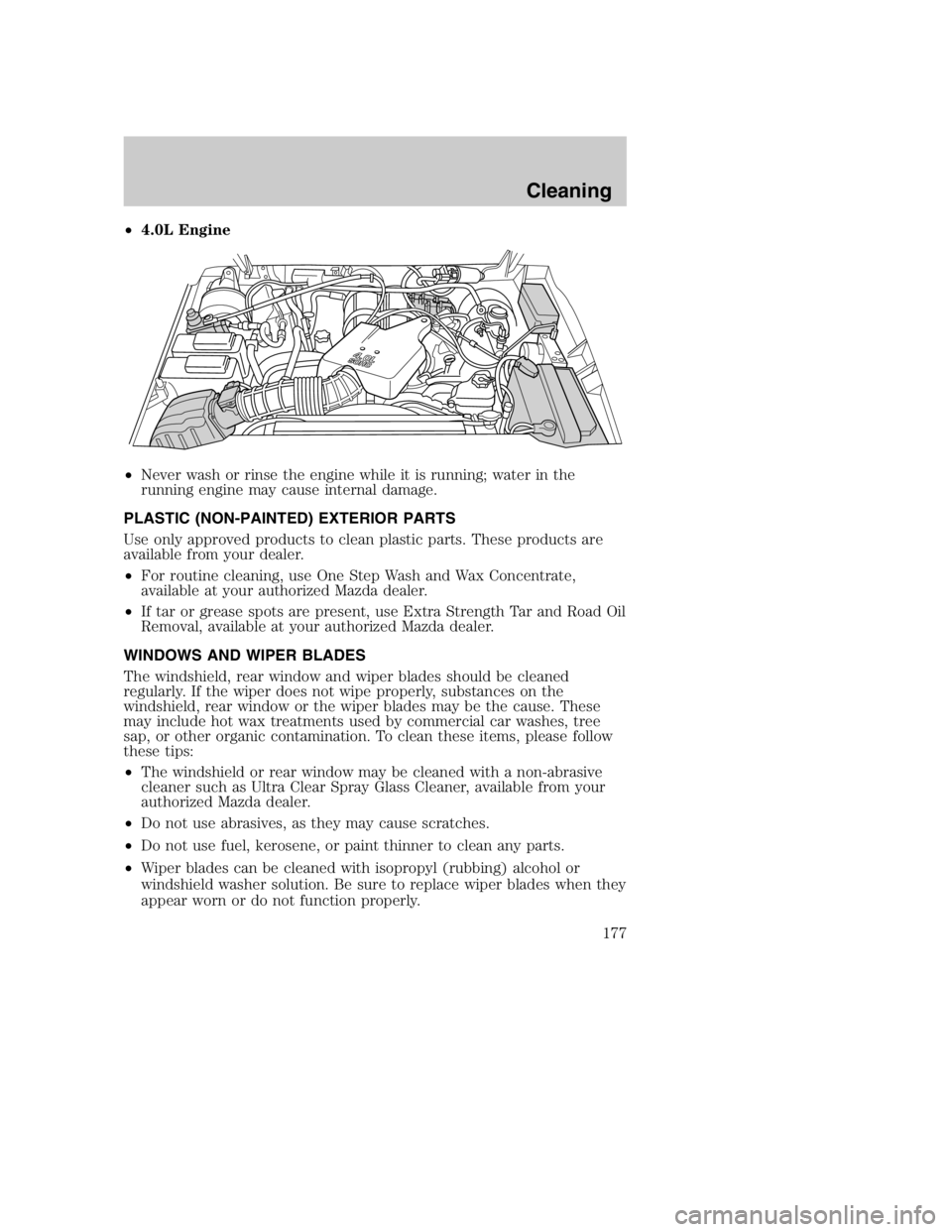
•4.0L Engine
• Never wash or rinse the engine while it is running; water in the
running engine may cause internal damage.
PLASTIC (NON-PAINTED) EXTERIOR PARTS
Use only approved products to clean plastic parts. These products are
available from your dealer.
• For routine cleaning, use One Step Wash and Wax Concentrate,
available at your authorized Mazda dealer.
• If tar or grease spots are present, use Extra Strength Tar and Road Oil
Removal, available at your authorized Mazda dealer.
WINDOWS AND WIPER BLADES
The windshield, rear window and wiper blades should be cleaned
regularly. If the wiper does not wipe properly, substances on the
windshield, rear window or the wiper blades may be the cause. These
may include hot wax treatments used by commercial car washes, tree
sap, or other organic contamination. To clean these items, please follow
these tips:
• The windshield or rear window may be cleaned with a non-abrasive
cleaner such as Ultra Clear Spray Glass Cleaner, available from your
authorized Mazda dealer.
• Do not use abrasives, as they may cause scratches.
• Do not use fuel, kerosene, or paint thinner to clean any parts.
• Wiper blades can be cleaned with isopropyl (rubbing) alcohol or
windshield washer solution. Be sure to replace wiper blades when they
appear worn or do not function properly.
2004 Mazda B Series (mbs)
Owners Guide (post-2002-fmt)
USA English (fus)
Cleaning
177
Page 182 of 256
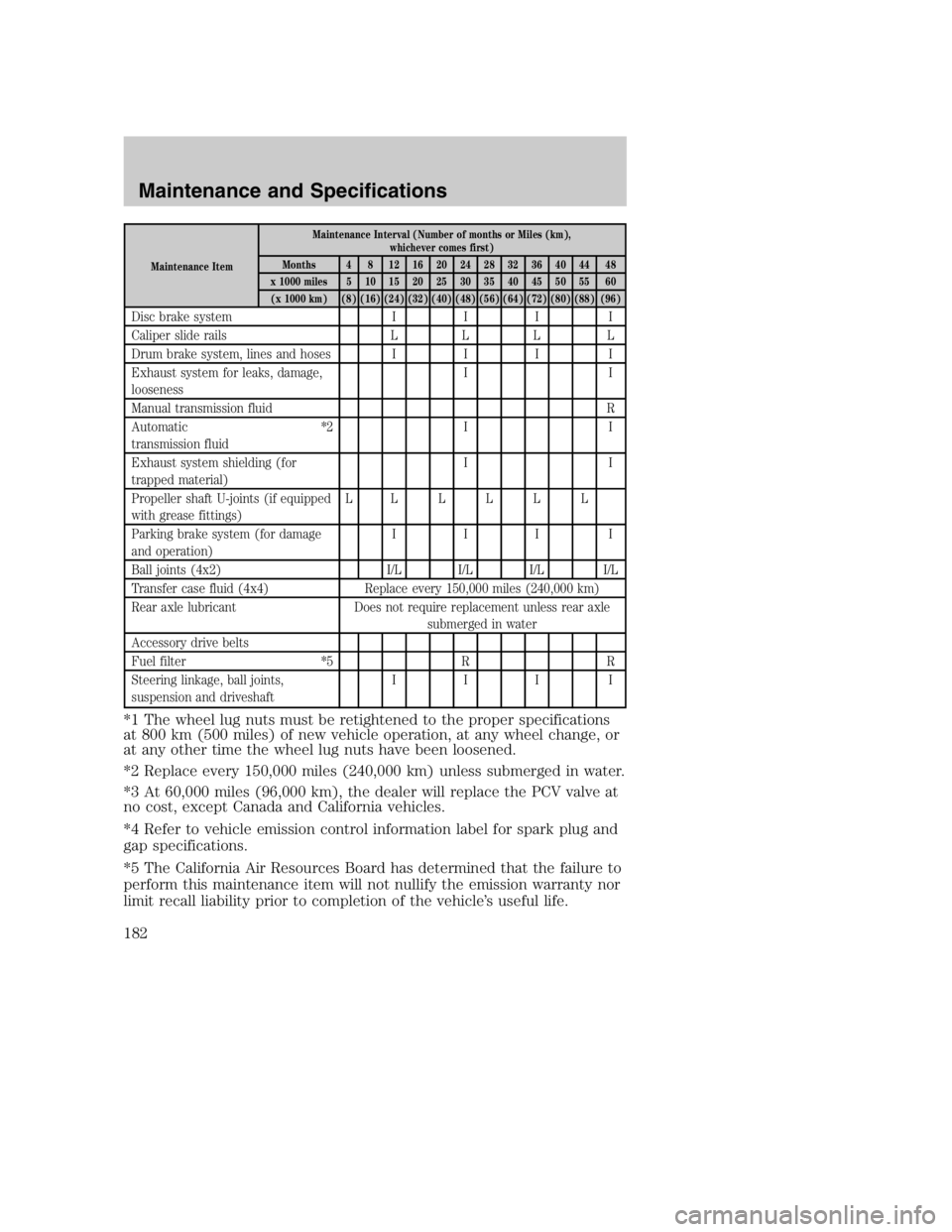
Maintenance ItemMaintenance Interval (Number of months or Miles (km),
whichever comes first)
Months 4 8 12 16 20 24 28 32 36 40 44 48
x 1000 miles 5 10 15 20 25 30 35 40 45 50 55 60 (x 1000 km) (8) (16) (24) (32) (40) (48) (56) (64) (72) (80) (88) (96)
Disc brake system III I
Caliper slide rails LLL L
Drum brake system, lines and hoses I II I
Exhaust system for leaks, damage,
looseness II
Manual transmission fluid R
Automatic
transmission fluid *2
I I
Exhaust system shielding (for
trapped material) II
Propeller shaft U-joints (if equipped
with grease fittings) LLLLLL
Parking brake system (for damage
and operation) III I
Ball joints (4x2) I/L I/L I/L I/L
Transfer case fluid (4x4) Replace every 150,000 miles (240,000 km)
Rear axle lubricant Does not require replacement unless rear axle
submerged in water
Accessory drive belts
Fuel filter *5R R
Steering linkage, ball joints,
suspension and driveshaft III I
*1 The wheel lug nuts must be retightened to the proper specifications
at 800 km (500 miles) of new vehicle operation, at any wheel change, or
at any other time the wheel lug nuts have been loosened.
*2 Replace every 150,000 miles (240,000 km) unless submerged in water.
*3 At 60,000 miles (96,000 km), the dealer will replace the PCV valve at
no cost, except Canada and California vehicles.
*4 Refer to vehicle emission control information label for spark plug and
gap specifications.
*5 The California Air Resources Board has determined that the failure to
perform this maintenance item will not nullify the emission warranty nor
limit recall liability prior to completion of the vehicle’s useful life.
2004 Mazda B Series
(mbs)
Owners Guide (post-2002-fmt)
USA English (fus)
Maintenance and Specifications
182